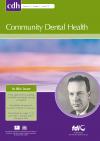Community Dental Health

- Cover Date:
- June 2010
- Print ISSN:
- 0265 539X
- Vol:
- 27
- Issue:
- 2
Reliability analysis of visual examinations carried out by schoolteachers and a dental assistant in the detection of dental caries.
Aim: This study aims to investigate the reliability of examinations performed by teachers and by a dental assistant in detection of cavitated surfaces. Methods: A sample of 168 students, aged 5–14 years, attending a public school in Duque de Caxias, Rio de Janeiro, was examined by persons with three different training backgrounds: a dentist, a dental assistant, and schoolteachers. Examinations were performed in the school with the aid of a tongue blade under natural light. Kappa statistics were estimated to assess agreement between the observers. Sensitivity, specificity, and positive and negative predictive value tests helped validate observations performed by the group of laypersons. Results: The findings suggest satisfactory agreement with the dentist, with kappa values of 0.730 and 0.781 for the teachers and the dental assistant, respectively. The absence of cavities was easily detected (specificity = 96%). More caution is required in positive results indicated by the teachers or the dental assistant because these were not always confirmed subsequently (sensitivity = 76%) by the dentist. Conclusion: The aid of untrained personnel in dental epidemiology was shown to be a valid alternative for a signposting role.
Key words: Dental assistant, dental caries, reliability, validity, schoolteachers, visual exam.
- Article Price
- £15.00
- Institution Article Price
- £
- Page Start
- 89
- Page End
- 93
- Authors
- A.S. Hecksher, R.R. Luiz, A.J.L. Costa, N.M. Moraes
Articles from this issue
- Title
- Pg. Start
- Pg. End
- A health equity methodology for auditing oral health and NHS General Dental Services in Sheffield, England.
- 68
- 73
- Effectiveness of structured comprehensive paediatric oral health education for parents of children less than two years of age in Germany
- 74
- 80
- Reliability analysis of visual examinations carried out by schoolteachers and a dental assistant in the detection of dental caries.
- 89
- 93
- Caries experience and oral health behaviour among 11 – 13-year-olds: an ecological study of data from 27 European countries, Israel, Canada and USA
- 102
- 108
- Development of a measure of childhood information learning experiences related to dental anxiety
- 122
- 128
